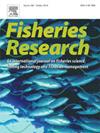海洋底栖无脊椎动物抽样调查设计的比较
IF 2.2
2区 农林科学
Q2 FISHERIES
引用次数: 0
摘要
海洋生物调查设计可以采取多种形式,一个重要的决定是如何在空间上分散有限的采样努力。本研究比较了系统、简单随机、分层随机和一种称为广义随机镶嵌分层(GRTS)的复杂空间平衡技术的抽样设计。比较使用了来自西北大西洋大西洋扇贝(麦哲伦扇贝)种群的既定光学调查数据。两项实地研究表明,尽管样本量有相当大的差异,但简单随机抽样和系统抽样的表现差异有限。模拟通过在更大范围的扇贝种群中分析六种采样技术,大大扩展了这项研究。这六种技术分别是简单随机抽样、分层随机抽样的三种变体(其方法不同)、系统抽样和GRTS抽样。通过平均扇贝密度估计值和该平均值的方差来评估每种技术的性能。所有的技术在整个过程中都是准确的,尽管分层随机技术的所有变体在一个低样本量的小区域是不准确和不精确的。分层随机和简单随机技术在接近真实精度方面是最好的。GRTS和系统技术精度高,但在估计真实精度方面较弱。这些结果强调,所有的技术都有权衡,并表明最优的统计调查设计是高度特定于目标物种的空间性质。本文章由计算机程序翻译,如有差异,请以英文原文为准。
A comparison of survey designs for marine benthic invertebrate sampling
Marine organism survey designs can take a wide range of forms, and an important decision is how to spread limited sampling effort over space. This study compared systematic, simple random, stratified random, and a sophisticated spatially balanced technique called generalized random tessellation stratified (GRTS), sampling designs. The comparison used data from an established optical survey of Atlantic sea scallop (Placopecten magellanicus) populations in the northwest Atlantic Ocean. Two field studies showed limited differences in the performance of simple random and systematic sampling, despite considerable differences in sample sizes. Simulations expanded this study considerably by analyzing six sampling techniques over a greater range of scallop populations. The six techniques were simple random sampling, three variants of stratified random sampling that differed in their methods for assigning stations to strata, systematic sampling, and GRTS sampling. The performance of each technique was assessed through the mean scallop density estimate and the variance of this mean. All techniques were accurate throughout, although all variants of the stratified random technique were inaccurate and imprecise in one small area with low sample size. The stratified random and simple random techniques were among the best at closely estimating the true precision. The GRTS and systematic techniques were highly accurate but weaker at estimating true precision. These results highlight that all techniques have tradeoffs and show that optimal statistical survey design is highly specific to the spatial nature of the species being targeted.
求助全文
通过发布文献求助,成功后即可免费获取论文全文。
去求助
来源期刊

Fisheries Research
农林科学-渔业
CiteScore
4.50
自引率
16.70%
发文量
294
审稿时长
15 weeks
期刊介绍:
This journal provides an international forum for the publication of papers in the areas of fisheries science, fishing technology, fisheries management and relevant socio-economics. The scope covers fisheries in salt, brackish and freshwater systems, and all aspects of associated ecology, environmental aspects of fisheries, and economics. Both theoretical and practical papers are acceptable, including laboratory and field experimental studies relevant to fisheries. Papers on the conservation of exploitable living resources are welcome. Review and Viewpoint articles are also published. As the specified areas inevitably impinge on and interrelate with each other, the approach of the journal is multidisciplinary, and authors are encouraged to emphasise the relevance of their own work to that of other disciplines. The journal is intended for fisheries scientists, biological oceanographers, gear technologists, economists, managers, administrators, policy makers and legislators.
 求助内容:
求助内容: 应助结果提醒方式:
应助结果提醒方式:


